-
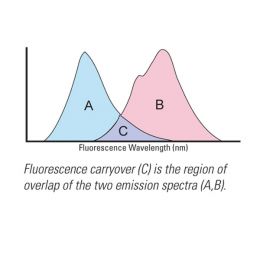 Simply Cellular® anti-Mouse Compensation StandardCatalog Number BLI550
Simply Cellular® anti-Mouse Compensation StandardCatalog Number BLI550The Simply Cellular® anti-Mouse Compensation Standard is a mixture of two Simply Cellular® anti-Mouse IgG particle populations capable of binding high and low levels of mouse monoclonal antibody used in your assay. Ideal for performing compensation in multicolor (2, 3, 4, or more) analysis.
A test requires one drop (50μl) of particle suspension, which is equivalent to ~100,000 particles. Bangs Flow Cytometry Standards are 7-9μm in diameter (unless otherwise noted) to approximate the size of human lymphocytes.
-
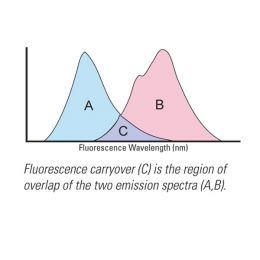 Simply Cellular® anti-Rat Compensation StandardCatalog Number BLI551
Simply Cellular® anti-Rat Compensation StandardCatalog Number BLI551The Simply Cellular® anti-Rat Compensation Standard is a mixture of two Simply Cellular® anti-Rat IgG particle populations capable of binding high and low levels of rat monoclonal antibody used in your assay. Ideal for performing compensation in multicolor (2, 3, 4, or more) analysis.
A test requires one drop (50μl) of particle suspension, which is equivalent to ~100,000 particles. Bangs Flow Cytometry Standards are 7-9μm in diameter (unless otherwise noted) to approximate the size of human lymphocytes.
-
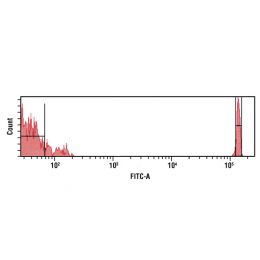 Viability Dye Compensation Standard, 4µmCatalog Number BLI450
Viability Dye Compensation Standard, 4µmCatalog Number BLI450Viability Dye Compensation Standards are suitable for labeling with LIVE/DEAD® stains or similarly-reactive dyes to generate compensation standards for flow cytometric analyses. Beads are not suitable for labeling with DNA stains such as propidium iodide, DAPI, or SYTOX®, and users should contact us for discussion if uncertain as to the compatability of a specific dye or stain.
-
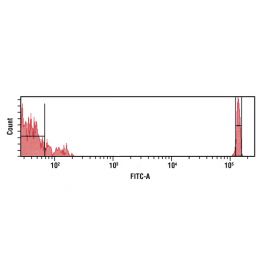 Viability Dye Compensation Standard, 8µmCatalog Number BLI451
Viability Dye Compensation Standard, 8µmCatalog Number BLI451Viability Dye Compensation Standards are suitable for labeling with LIVE/DEAD® stains or similarly-reactive dyes to generate compensation standards for flow cytometric analyses. Beads are not suitable for labeling with DNA stains such as propidium iodide, DAPI, or SYTOX®, and users should contact us for discussion if uncertain as to the compatability of a specific dye or stain.
-
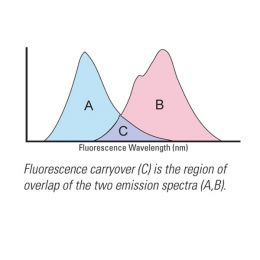 Simply Cellular® anti-Human Compensation StandardCatalog Number BLI552
Simply Cellular® anti-Human Compensation StandardCatalog Number BLI552Used in conjunction with hardware or software to remove spectral overlap from fluorochromes into secondary fluorescence detectors of a flow cytometer. Flow cytometers are designed to have a primary detector for each fluorochrome label (e.g. FL1- FITC, FL2- PE, FL3- PE-Cy™5). Fluorescent signals emitted by fluorochromes can bleed or overlap into the secondary fluorescence detectors.
The Simply Cellular® Compensation Standard is a mixture of 2 populations of microspheres that have the ability to bind human monoclonal antibodies at high and low capacities, respectively. The microspheres are supplied in a sterile-filtered, pH buffered PBS solution containing surfactant and preservatives. As the operator labels these standards with the same antibody used to label the cell samples, the standards will exhibit spectral properties that closely match the cells being analyzed.
-
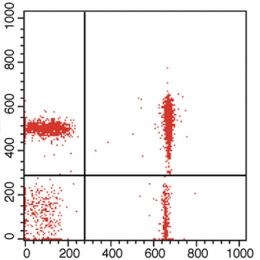 FITC/PE Compensation StandardCatalog Number BLI820A
FITC/PE Compensation StandardCatalog Number BLI820AThe FITC/PE Compensation Standard is a convenient means of setting two color compensation on a flow cytometer. Each kit contains an Autofluor™ bead, as well as a bead labeled with FITC, a bead labeled with PE, and one labeled with both FITC and PE.
A test requires one drop (50μl) of particle suspension, which is equivalent to ~100,000 particles. Bangs Flow Cytometry Standards are 7-9μm in diameter (unless otherwise noted) to approximate the size of human lymphocytes.
-
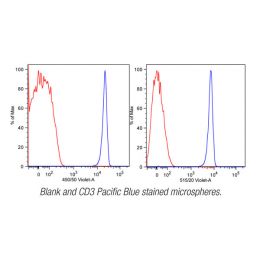 Simply Cellular® anti-Mouse for Violet LaserCatalog Number BLI835
Simply Cellular® anti-Mouse for Violet LaserCatalog Number BLI835The Simply Cellular® anti-Mouse for Violet Laser standard features microspheres comprised of a proprietary matrix that exhibits low autofluorescence with violet excitation. Beads are suitable for labeling with mouse Abs conjugated with violet fluorochromes, and for use as a compensation or general reference standard for detectors off of the violet laser. Beads are also suitable for use with other fluorochromes / detectors, e.g. 488nm, 633nm. They are supplied in aqueous suspension containing ProClin®.
Compensation Beads
